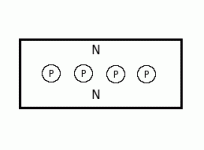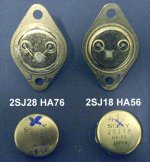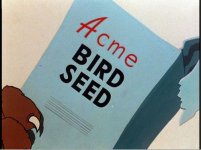Anyone with the huevos to design, then have a transistor manufactured, deserves the fruits of his labors.
So you're saying Nelson has ovaries? I never woulda guessed.
The name "Static Induction Transistor" was certainly created by a genius in Physics but not by a good English speaker.
There is certainly nothing static inside, nor is electromagnetic induction taking place in the traditional sense (But Nishizawa probably already envisioned GHz-Applications ..).
He probably wanted to say "Electrostatic Field Induced Voltage Transistor" "EFIVT" but ended up with "SIT". I'm sure the marketing people at Sony and Yamaha understood the principle quite well, but spoke a better English,and thus came to the point.
I dunnow 'bout that. The name "SIT" goes back to the early 1950s. By that time, it was widely recognized that transistors were hideously non-linear, and the "holy grail" of SS design was a device that was as linear as the triode VT. (Often promised; seldom delivered.)
The first attempt (attached) literally tried to duplicate the internal mechanics of a triode, with the N-type semiconductor serving as the "cathode" and "plate" with the P-type forming the "control grid". The design worked, so far as linearity was concerned, but attained a Gm of a whopping 200uA/V. Not exactly practical.
Attachments
Nelson,
...Please find enclosed a picture, which shows the two dies of an opened 2SK82.
Mirko
Actually, single die 2SK82/2SJ28 DO exist. Apparently the early devices were made that way, and here is the proof, from a failed 2SJ28 I have here, in comparison to a 3x3mm die of a 2SJ18 - note the rank numbers (Yes, there are 2SJ28/2SK82 other than rank 3, dont ask
Attachments
Interesting, especially the wide, yellowish edge passivation, which I didn't see in a Sony V-FET so far (Looks more like Yamaha dies).
Process change ? Second Generation ? OEM by Hitachi/Yamaha/NEC ?
Interestingly none of the 2SJ28/2SK82 I pulled from real TA-N88Bs (6 amplifiers so far) ever had a transistor with such a rank, suggesting single die.
Do you have any idea, if these single die transistors were ever shipped in TA-N88B production units ?
What does a microscope say, same basic process geometry ?
Process change ? Second Generation ? OEM by Hitachi/Yamaha/NEC ?
Interestingly none of the 2SJ28/2SK82 I pulled from real TA-N88Bs (6 amplifiers so far) ever had a transistor with such a rank, suggesting single die.
Do you have any idea, if these single die transistors were ever shipped in TA-N88B production units ?
What does a microscope say, same basic process geometry ?
The PASS-SIT-1 is probably one of only a few parts with the right specs to build a practical single stage amp with a selector switch for zero feedback, degenerative feedback, and loop feedback.
Of course, I realize that's not the point, but has it been done experimentally?
Specs, yes. Is there a spec sheet available for the PASS-SIT-1's?
Yes, I have the SPICE model from Mike.I think Mike has made a good SPICE model of the part.

I was hoping there was a proper spec sheet available though. Did SemiSouth provide one for you?
If not, I am interested in: Cin, RdsON, Idmax, Vth, gfs, mu etc.
I think Mike has made a good SPICE model of the part.

Interelectrode capacitances aren't included in the free web model though. I've ordered the Linear 6 magazine to get the more complete model from Mike (which hopefully includes the capacitances).
It would be easy enough to put the interelectrode capacitances into the Koren-based model on my blog if you know them. Of course, they are static. The article in LA doesn't include any info about PASS-SIT-1.
I made the Koren model from the curves NP has published in his articles. I don't know how "literal" the published curves are, and I've never made any of my own because I'm so anxious about accidentally destroying one.
I made the Koren model from the curves NP has published in his articles. I don't know how "literal" the published curves are, and I've never made any of my own because I'm so anxious about accidentally destroying one.
Yeah, that's the problem. It's surprising that Nelson has output curves but no datasheet for the PASS-SIT-1 device. Perhaps he generated the curves himself.It would be easy enough to put the interelectrode capacitances into the Koren-based model on my blog if you know them.
Wish I'd known that before I ordered it. Oh well, there are a few useful tidbits of info in Volume 6.The article in LA doesn't include any info about PASS-SIT-1.
Now that I have the Linear 6 bookzine, I am a little disappointed because there is no new model for the PASS-SIT-1 included. And also because your program only works in Chrome, which I don't use. Why would it not work generically?I made the Koren model from the curves NP has published in his articles.
Is the older SPICE model of the PASS-SIT-1 device that is freely available on your blog here good enough in your opinion?
to each his own wabbit

Hmmm,
Is there some purpose to these nonsensical one-liners?
Everyone is entitled to their opinion. If reading this thread is too hard on your psyche, then perhaps you shouldn't.is there some purpose in harassing for model of unobtanium part ?
questioning , along , good intentions and qualifications of good man ?
Furthermore, I'm quite certain Mike and Nelson can speak for themselves.
Furthermore, I'm quite certain Mike and Nelson can speak for themselves.
And so I will...
Yeah, that's the problem. It's surprising that Nelson has output curves but no datasheet for the PASS-SIT-1 device. Perhaps he generated the curves himself.
It's not really surprising that a bespoke, unobtainable part doesn't come with a data sheet. So, maybe we could cut him some slack.
I'd known that before I ordered it. Oh well, there are a few useful tidbits of info in Volume 6.
Did someone tell you that there was information about PASS-SIT-1 to be found in the article? The abstract doesn't seem to suggest that.
Now that I have the Linear 6 bookzine, I am a little disappointed because there is no new model for the PASS-SIT-1 included. And also because your program only works in Chrome, which I don't use. Why would it not work generically?
I'm awfully sorry the magazine you bought doesn't contain the thing you imagined it would despite the fact that the abstract mentions nothing of PASS-SIT-1. Incidentally, my email address is working fine. You could have asked. Ask anyone here, I'm quite responsive to emails.
I'm also sorry that some browsers don't support all of HTML5. Writing a program like that takes a lot of time, and in between writing articles, making videos, building projects, oh and my day job, I really didn't have the extra hours available to program work arounds for IE, Safari, or God knows what. If installing Chrome is a problem for you, I'm sorry I can't help.
I'm suddenly sorry for a lot of things.
Is the older SPICE model of the PASS-SIT-1 device that is freely available on your blog here good enough in your opinion?
It depends, good enough for what? What are you making with these unobtainable parts?
It models IV curves, which is of primary interest to most DIYers because they're usually interested in how much current comes out when you put so much voltage in, and so on. It doesn't model temperature, or capacitance (unless you put them in). It's about as complete as many of the vacuum tube models that are used everyday to try-out little amplifier circuits. And, in that sense, it is useful to get a feel for how the device will behave before you build with it.
On the other hand, it doesn't model everything else. So, if you want to hang out with the sim guys and blather on as if you were talking about a real circuit and making real observations about johnson noise, and spectra-this, quantum-that, and what George Costanza would call "mental masturbation", you'll be left wanting.
Nonetheless, given your level of disappointment so far, I doubt that it would be good enough for you.
- Status
- This old topic is closed. If you want to reopen this topic, contact a moderator using the "Report Post" button.
- Home
- Amplifiers
- Pass Labs
- First taste of Papa's new devices



